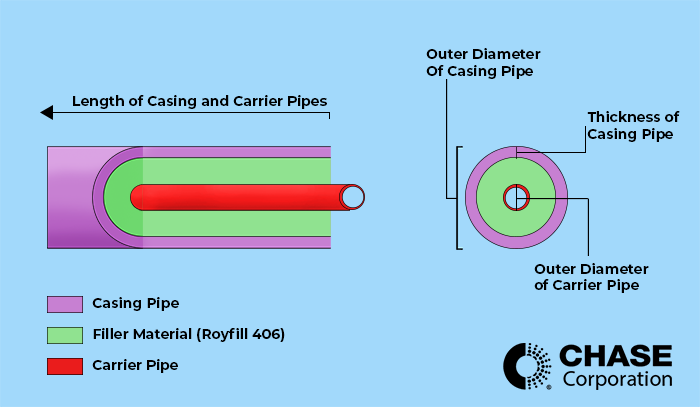Calculate and Fill Pipeline Casings with the Right Volume of Filler

Pipeline casings, also known as pipeline sleeves or conduits, are protective structures used to encase pipelines that pass through various obstacles or environments. They serve to shield the pipeline from external forces, provide additional support, and prevent contact with potentially damaging elements. Casings are larger in diameter than the enclosed pipeline and are made from materials such as steel, concrete, or high-density polyethylene (HDPE).
Protective pipeline casings are commonly used in high-consequence environments where pipelines must pass under roads, railways, water bodies, or areas with geological features that could risk the pipeline’s integrity. The pipeline is safeguarded from potential damage caused by external factors like ground movement, vehicle traffic, or corrosion by installing a casing.
These casings use a protective filler to house the delicate carrier pipe. For this, we highly recommend our Royfill 406. Whatever filler you choose, it's essential to know the volume of filler required. This blog will review that calculation and outline the steps required to properly fill the casing pipe.
Related Article: Protecting Pipelines During Pipeline Backfilling
How to Calculate the Volume of Filler Needed for Pipeline Casings
To determine the Volume (gallons) of petrolatum compound needed to fill the annular space, we must first gather details of the pipe casing and the encased pipeline:
- Outside diameter (O.D.) of the casing pipe (inches)
- The wall thickness of the casing pipe (inches)
- The outside diameter (O.D.) of the carrier pipe (inches)
- Length of the casing and carrier pipe (feet)
To calculate the gallons of petrolatum compound needed, use the following formula for Volume:

Key:
V = Volume in gallons
D = Diameter of pipe in inches
π = 3.14159
L = Length of pipe in feet
How to Fill Pipeline Casings
A petrolatum-based, liquid-filler wax is pumped into the low-end, bottom casing vent using an insulated, heated tanker truck and factory-trained installers. The pumping continues until the filler is discharged from the high-end casing vent. The manufacturer’s application guide, product data sheet, and SDS provide additional information.
- The vents must be clear and open into the casing
- Make certain there are vents on both ends
- Conduct a pressure check to ensure the end seals are in place and there are no leaks
- Pressure check boot seals to a minimum of 5-psi
- Pressure test link seals to a minimum of 10-psi
- Failure to pressure test the end seals ahead of time could result in a downtime of crew and added expenses
- Water within the casing pipe must be removed
- The casing must be clear and free of any debris
In summary, pipeline casings are protective structures that enclose pipelines, providing support against external forces and potentially corrosive environments. Remember, most pipe casings are color-coded, and you can use our pipe color code guide to help tell at a glance. The specific corrosion protection measures employed may vary depending on factors such as the type of pipeline, environmental conditions, and regulatory requirements. It’s advisable to consult with corrosion engineers or pipeline experts to determine the most suitable corrosion protection strategy for a particular casing.
Tapecoat and Royston tape coating systems provide corrosion protection to critical pipeline infrastructure. Our technical representatives can assist you with product information to meet your coating needs. Please contact us.







